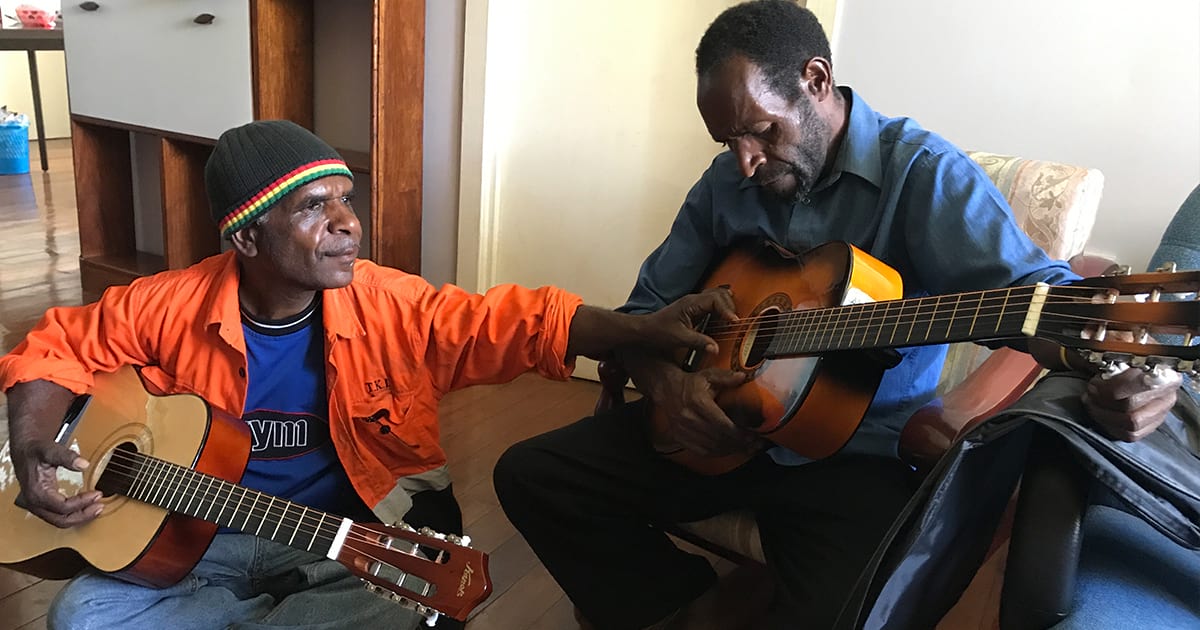
The monthly “From the Mission Field” column includes brief updates from LCMS missionaries around the world.
Dr. Martin Dicke, LCMS missionary and sacred music educator to Papua New Guinea (PNG), recently completed a project with Badu Amos*, who serves as director of youth ministry at Timothy Lutheran Church in Birip, PNG. As part of his service, Amos helps lead the youth in singing for worship. He has also composed many songs.
Dicke said that soon after he arrived in PNG, he encouraged Amos to write his compositions down so they could be preserved and passed on to the next generation. Dicke provided Amos with paper and writing utensils, and several months later, Amos came back with 100 songs in Melanesian Pidgin that he had written down.
“We then set about to record them,” Dicke wrote in a recent newsletter. “We held about 10 recording sessions with the youth and recorded 51 of [the songs]. This year I was finally able to complete a book containing all these songs and to finish editing the audio recordings. Then the problem was finding a way to allow the people in PNG to play and hear the songs [since] there is little to no electricity.
“I was able to find some solar-powered MP3 players … [and] I’m happy to report that at this stage we have been able to deliver six copies of the songbook and 49 MP3 players.”
Dicke added that Amos continues to write and record more songs and that Amos and the Rev. Jerry Pyao, pastor of Timothy, plan to travel throughout the six regions of the Gutnius (Good News) Lutheran Church in the Enga Province to share them.
Dicke wrote, “We pray that God will provide them the support they need and richly bless their efforts. By singing the songs that God gave us in the Bible … [and] the songs and hymns of the faithful poets and composers of the past and present, we learn theology. By singing these songs, we become viva vox evangelii — ‘the living voice of the Gospel.’ Soli deo Gloria!”
*Below, Dicke shares additional background about Badu Amos:
Badu’s father was born on the Huon Peninsula near Finschhafen and was a descendant of the first Lutheran Christians in PNG. They were instructed and baptized by Rev. Johann Flierl (1858–1947), who was born in Germany and educated at the Rev. Wilhelm Loehe’s mission school in Neuendettelsau.
Flierl wanted to become a missionary in the U.S., but that never worked out. He went to Australia instead, and when a German colony was established in PNG in 1885, he determined to go there. He arrived in 1886, but the people were initially not receptive to the Good News. After 13 years of ministry, he held the first baptisms — of only two people. Eventually, more were converted and baptized, more stations established, and more missionaries came to help.
Of course, there were many struggles along the way, but these first PNG Lutheran Christians were so passionate about the faith that they were willing to leave their home and travel and resettle in other parts of the country to help start other missions. When the Australian Lutherans opened up mission work in Mount Hagen (two hours from the Enga Province), Badu’s father went to help. He married a woman from Mount Hagen and began a family. When the LCMS opened up mission work in the Enga Province in 1948, Badu’s father volunteered to resettle again and came to help. He was assigned to Birip and was a founding member of Timothy Lutheran congregation. Badu was born at Birip.
Some additional helpers came direct from the Huon Peninsula to help the first LCMS missionaries. Some of them walked to Madang and then were flown either to Wabag or to Mount Hagen. Some walked all the way from the Huon Peninsula to Yaramanda in the Enga Province, where the first LCMS mission station was. That trek overland would have taken them several weeks. This is all part of Badu’s heritage. — Martin Dicke
Posted Dec. 12, 2022